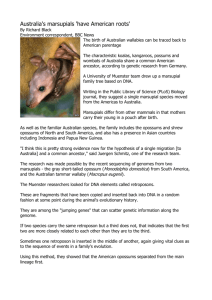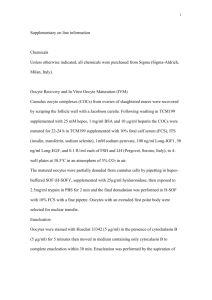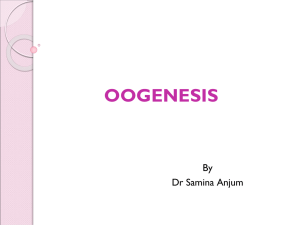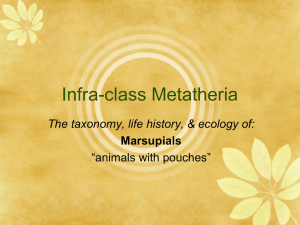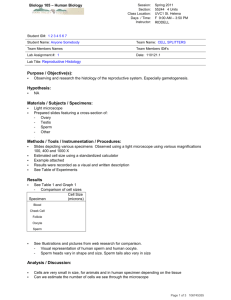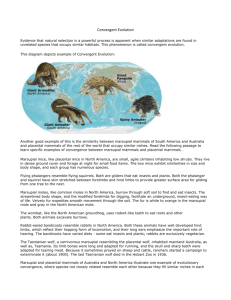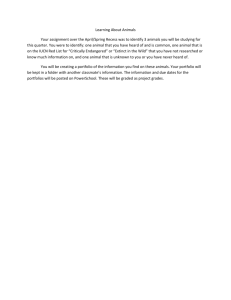Advantages of Studying Marsupial Oocytes, Fertilisation and
advertisement
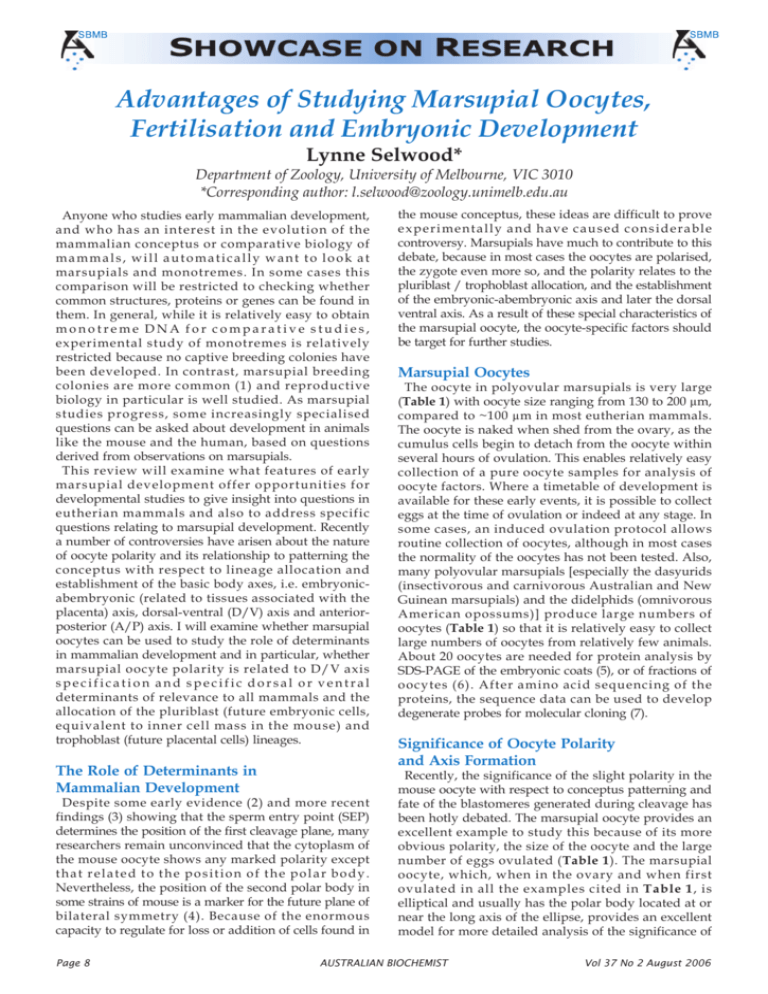
SHOWCASE ON RESEARCH Advantages of Studying Marsupial Oocytes, Fertilisation and Embryonic Development Lynne Selwood* Department of Zoology, University of Melbourne, VIC 3010 *Corresponding author: l.selwood@zoology.unimelb.edu.au Anyone who studies early mammalian development, and who has an interest in the evolution of the mammalian conceptus or comparative biology of mammals, will automatically want to look at marsupials and monotremes. In some cases this comparison will be restricted to checking whether common structures, proteins or genes can be found in them. In general, while it is relatively easy to obtain monotreme DNA for comparative studies, experimental study of monotremes is relatively restricted because no captive breeding colonies have been developed. In contrast, marsupial breeding colonies are more common (1) and reproductive biology in particular is well studied. As marsupial studies progress, some increasingly specialised questions can be asked about development in animals like the mouse and the human, based on questions derived from observations on marsupials. This review will examine what features of early marsupial development offer opportunities for developmental studies to give insight into questions in eutherian mammals and also to address specific questions relating to marsupial development. Recently a number of controversies have arisen about the nature of oocyte polarity and its relationship to patterning the conceptus with respect to lineage allocation and establishment of the basic body axes, i.e. embryonicabembryonic (related to tissues associated with the placenta) axis, dorsal-ventral (D/V) axis and anteriorposterior (A/P) axis. I will examine whether marsupial oocytes can be used to study the role of determinants in mammalian development and in particular, whether marsupial oocyte polarity is related to D/V axis specification and specific dorsal or ventral determinants of relevance to all mammals and the allocation of the pluriblast (future embryonic cells, equivalent to inner cell mass in the mouse) and trophoblast (future placental cells) lineages. The Role of Determinants in Mammalian Development Despite some early evidence (2) and more recent findings (3) showing that the sperm entry point (SEP) determines the position of the first cleavage plane, many researchers remain unconvinced that the cytoplasm of the mouse oocyte shows any marked polarity except that related to the position of the polar body. Nevertheless, the position of the second polar body in some strains of mouse is a marker for the future plane of bilateral symmetry (4). Because of the enormous capacity to regulate for loss or addition of cells found in Page 8 the mouse conceptus, these ideas are difficult to prove experimentally and have caused considerable controversy. Marsupials have much to contribute to this debate, because in most cases the oocytes are polarised, the zygote even more so, and the polarity relates to the pluriblast / trophoblast allocation, and the establishment of the embryonic-abembryonic axis and later the dorsal ventral axis. As a result of these special characteristics of the marsupial oocyte, the oocyte-specific factors should be target for further studies. Marsupial Oocytes The oocyte in polyovular marsupials is very large (Table 1) with oocyte size ranging from 130 to 200 µm, compared to ~100 µm in most eutherian mammals. The oocyte is naked when shed from the ovary, as the cumulus cells begin to detach from the oocyte within several hours of ovulation. This enables relatively easy collection of a pure oocyte samples for analysis of oocyte factors. Where a timetable of development is available for these early events, it is possible to collect eggs at the time of ovulation or indeed at any stage. In some cases, an induced ovulation protocol allows routine collection of oocytes, although in most cases the normality of the oocytes has not been tested. Also, many polyovular marsupials [especially the dasyurids (insectivorous and carnivorous Australian and New Guinean marsupials) and the didelphids (omnivorous American opossums)] produce large numbers of oocytes (Table 1) so that it is relatively easy to collect large numbers of oocytes from relatively few animals. About 20 oocytes are needed for protein analysis by SDS-PAGE of the embryonic coats (5), or of fractions of oocytes (6). After amino acid sequencing of the proteins, the sequence data can be used to develop degenerate probes for molecular cloning (7). Significance of Oocyte Polarity and Axis Formation Recently, the significance of the slight polarity in the mouse oocyte with respect to conceptus patterning and fate of the blastomeres generated during cleavage has been hotly debated. The marsupial oocyte provides an excellent example to study this because of its more obvious polarity, the size of the oocyte and the large number of eggs ovulated (Table 1). The marsupial oocyte, which, when in the ovary and when first ovulated in all the examples cited in Table 1, is elliptical and usually has the polar body located at or near the long axis of the ellipse, provides an excellent model for more detailed analysis of the significance of AUSTRALIAN BIOCHEMIST Vol 37 No 2 August 2006 Marsupial Oocytes, Fertilisation and Embryonic Development SHOWCASE ON RESEARCH Table 1. Examples of oocyte size and number and their method of collection in some polyovular marsupials. av − average; T/T − timetable; I − induced ovulation protocol available. References are in superscript; data without references appear for the first time in this article. Species Family Oocyte Size µm Oocyte number Collection Sminthopsis macroura Dasyuridae 196 + 11 (S.E.)17 27 av T/T15, I18 Antechinus agilus Dasyuridae 131 + 317 13 av T/T15 Monodelphis domestica Didelphidae 140 av19 14 av5 T/T15, 19 Didelphis virginiana Didelphidae 150 av20 22 av T/T20 oocyte polarity. The dasyurid marsupials, in the examples cited above, also have a visible cytoplasmic polarity, with vesicular material accumulated at one pole (abembryonic pole) and a polarised location of the female nuclear material (embryonic pole) at the other. In the examples from the didelphids, polarity becomes visible at the zygote stage following fertilisation. Cytoplasmic patterning in the oocyte and zygote is reflected in the development of the embryonicabembryonic axis and then the D/V axis (8). Whether this obvious patterning is related to the uneven distribution of determinants in the oocyte is currently unknown. Certainly in two marsupials, Monodelphis domestica (grey short-tailed opossum) (9) and Sminthopsis macroura (stripe-faced dunnart) (8), sperm entry which brings in the centrosome is associated with the initiation or reinforcement of polarity and cytoplasmic movements may be equivalent to the cortical rotation found in amphibians. Oocyte Polarity and Pluriblast-Trophoblast Allocation Where pluriblast-trophoblast allocation has been studied in marsupials, the polarised oocyte predicts the eventual separation into the two cell types, pluriblasts (future embryonic cells) and trophoblasts (future placental cells). Markers for the trophoblast are relatively rare in mammals and it is possible that following this lineage allocation in marsupials might reveal markers that are also found in eutherian mammals. Where the allocation has been examined, the trophoblast cells are distinct from the pluriblast cells in the unequal distribution of cytoplasmic organelles, e.g. the trophoblast cells are far richer in vesicles of various types. Conceptus Culture During Organogenesis A major underutilised resource in marsupial development is the ability to culture conceptuses from the appearance of the hypoblast just prior to gastrulation until most organ systems are formed. In S. macroura, culture can be extended to within five hours of birth (10). In comparison, eutherian mammals can usually be cultured for relatively short periods during gastrulation and organogenesis; usually around 24-48 hours (11). Marsupials are born at an altricial (immature) stage of development, but nevertheless, Vol 37 No 2 August 2006 most organ systems are formed by birth, and growth and differentiation of the organs proceed post-natally during lactation. Nelson (12) has placed a marsupial Dasyurus hallucatus (northern quoll) at birth and during lactation into the Carnegie Staging system, as modified by Streeter and O'Rahilly and more recently summarised by Gribnau and Geijsberts (13), so that direct comparisons with eutherian mammals can be made. D. hallucatus is at a similar stage to S. macroura at birth. He also compared a number of other marsupials, namely Didelphis virginiana (Virginian opossum), Trichosurus vulpecula (common brushtail possum), Macropus eugenii (tammar wallaby), with Dasyurus, so that they also can be placed into the modified Carnegie System. Marsupials are born at modified Carnegie Stages 15 (D. hallucatus, S. macroura) to 17 (D. virginiana) and organogenesis is completed at Carnegie Stage 23, when all organs and organ systems have developed (12). In D. hallucatus, Stage 23 occurs on day 33 of lactation. During the remainder of the lactation period, which ends after 125 days, the organ systems grow and differentiate as they do in advanced fetal stages of the mouse. In the mouse, the modified Carnegie Stage 15 occurs around day 15 of gestation and Stage 23 occurs just before birth. Techniques to allow development during gastrulation and organogenesis in culture in marsupials were first developed by New and Mizell (14), who recognised that culturing marsupials at these stages provided opportunities not readily available in other mammals. They and others (15) pushed development in vitro to later stages of organogenesis. More recent studies have improved culture conditions by the use of explants of the embryonic area (16) for peri-gastrulation stages or roller culture systems (10) for organogenesis to near birth. The conclusion of these most recent studies are that for further development, peri-gastrulation explants should be cultured in systems that improve oxygen delivery to the explants and that roller culture of fetal stages requires oxygen concentrations of >20% and additional serum supplements in the media. Both the New and Selwood groups used polyovular species in which the implanted embryonic stages needed to be dissected from the uterine wall, with only part of the choriovitelline yolk sac placenta retained in vitro. However, if monovular species, which have AUSTRALIAN BIOCHEMIST Page 9 Marsupial Oocytes, Fertilisation and Embryonic Development SHOWCASE ON RESEARCH superficial and late implantation, were chosen for roller culture, the opportunity to culture the entire conceptus would be available. A very good model for this would be T. vulpecula, in which implantation occurs at various stages between the mid-somite stage and very late embryogenic stages on the day of birth. In those specimens in which the shell coat persists until late in gestation, the presence of the shell would prevent the placenta sticking to the wall of the roller culture vessel. The accessibility of marsupial embryos in utero when most organ systems are developing provides an unprecedented opportunity to study organogenesis in vitro for most if not all of organogenesis. In vitro development allows for a variety of experimental manipulations and analyses, not always possible in vivo. Surprisingly this opportunity has been very little utilised. Pre-natally, experimental manipulations of marsupial embryos have not been carried out, even though the near complete organogenesis of the nervous, digestive, cardiovascular and respiratory systems can be studied in vitro. Postnatal development of the pouch young has been used to advantage to examine sex determination and development of the reproductive tract and differentiation of the nervous system and its capacity to regenerate. However, development of the eye, the ear and the excretory system, especially the kidney, have received little attention. 7. Cui, S., and Selwood, L. (2003) Mol. Reprod. Devel. 65, 141-147 8. Selwood, L. (2001) Reproduction 121, 677-683 9. Breed, W.G., Simerly, C., Navara, C.S. VandeBerg, J.L., and Schatten, G. (1994) Dev. Biol. 164, 230-240 10. Cruz, Y.P., Hickford, D., and L. Selwood. (2000) J. Reprod. Fertil. 120, 99-108 11. Cockroft, D.L. (1997) Int. J. Dev. Biol. 41, 127-138 12. Nelson, J. (1992) Anat. Embryol. 175, 387-398 13. Gribnau, A.A.A., and Geijsberts, L.G.M. (1981) Adv. Anat. Embryo. Cell Biol. 68, 1-79 14. New, D.A.T., and Mizell, M. (1972) Science 175, 533- 536 15. Selwood, L., Robinson, E.S., Pedersen, R.A., and Vandeberg, J.L. (1997) Int. J. Dev. Biol. 41, 397-410 16. Hickford, D., and Selwood, L. (2003) Mol. Reprod. Devel. 65, 402-419 17. Selwood, L. (1992) in Current Topics in Developmental Biology (Pedersen, R.A., ed) pp. 175233, Academic Press 18. Hickford, D.E., Merry, N.E., Johnson, M.H., and Selwood, L. (2001) Reproduction 122, 777-783 19. Mate, K.E., Robinson, E.S., VandeBerg, J.L., and Pedersen, R.A. (1994) Molec. Reprod. Dev. 39, 365-74 20. McCrady, E., Jr. (1938) Am. Anat. Mem. 16, 1-233 Conclusions Marsupial conceptuses provide valuable models for studying pattern formation in developing mammals because of the polarised oocyte and early conceptus. The study of these stages should yield information on body axis formation, especially the establishment of the D/V axis in mammals and the first lineage allocation into embryonic (pluriblast, epiblast) and placental (trophoblast, hypoblast) lineages. Because of the size, number and visible polarity of the oocytes and zygotes, the possibility of isolating molecules associated with these processes is high and has already borne fruit, with the isolation of the first oocyte vesicle associated protein (VAP1) in the dunnart (6). The relative brevity of the gestation period, the accessibility of the conceptuses and the availability of culture systems allowing development in vitro over most of organogenesis to within five hours of birth provides great opportunities for novel analysis of organogenesis, not currently possible in eutherian mammals. References 1. Selwood, L., and Cui, S. (2006) Austr. J. Zool. in press 2. Denker, H.W. (1976) Curr. Top. Pathol. 61, 59-79 3. Zernika-Goetz, M. (2002) Development 129, 815-829 4. Gardener, R. (1997) Development 124, 289-301 5. Casey, N.P., Martinus, R., and Selwood, L. (2002) Mol. Reprod. Devel. 62, 181-194 6. Cui, S., Nikolovski, S., Nanayakkara, K., and Selwood, L. (2005) Mol. Reprod. Devel. 71, 19-28 Page 10 AUSTRALIAN BIOCHEMIST Vol 37 No 2 August 2006
